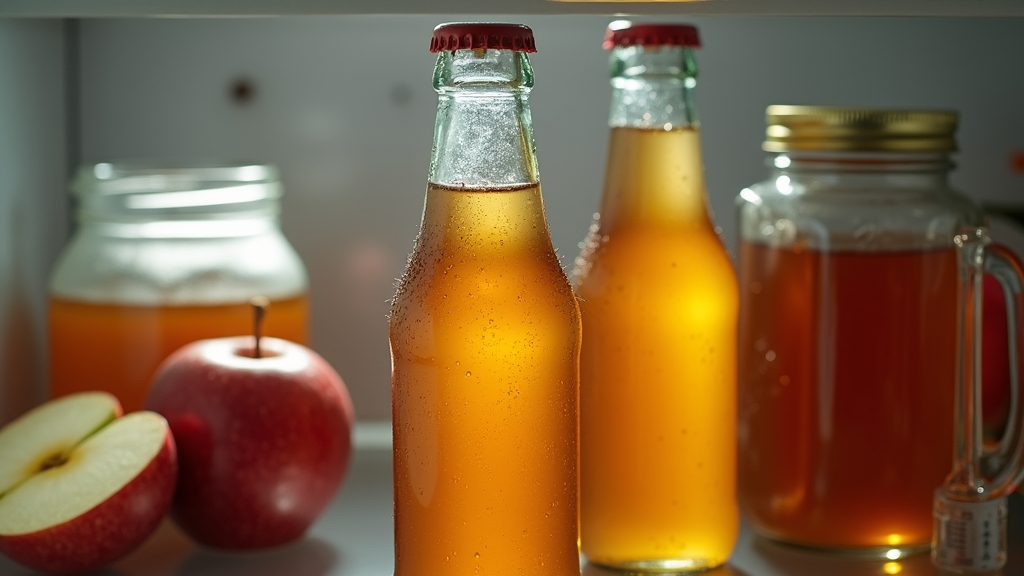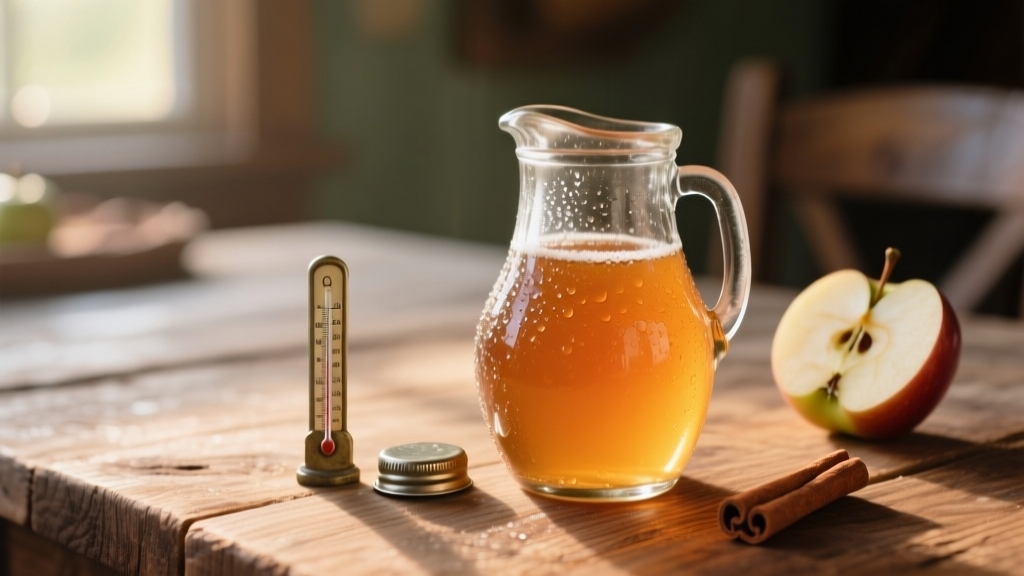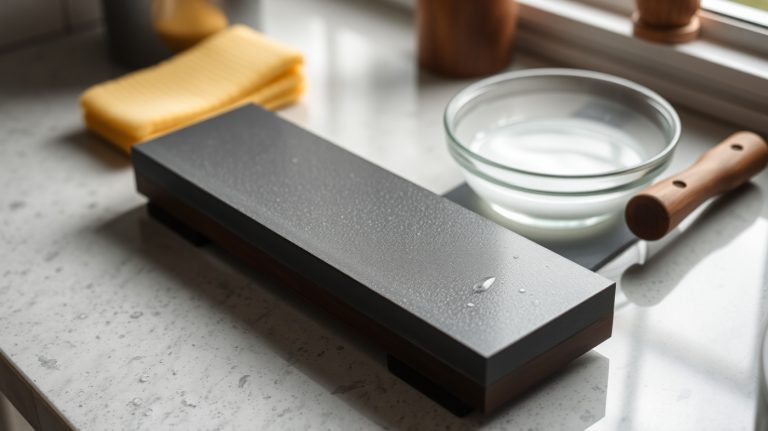How Long Does Pasteurized Apple Cider Last? Storage Guide
You can keep unopened pasteurized apple cider refrigerated for up to two weeks. Once opened, it stays fresh about 7 to 10 days if sealed tightly and stored below 40°F.
To maintain quality, use airtight containers and keep it away from temperature changes. You can also freeze cider for up to a year, but thaw it slowly and consume within a few days. Understanding these details can help you preserve its flavor and safety effectively.
Key Takeaways
- Unopened pasteurized apple cider typically lasts 1–2 weeks refrigerated, with some varieties lasting up to 1 year if stored airtight and cold.
- Once opened, pasteurized cider stays fresh for 7–10 days when refrigerated at or below 40°F (4°C) and sealed tightly.
- Freezing pasteurized apple cider extends shelf life up to 12 months; thaw slowly in the refrigerator and consume within 3–5 days.
- Proper storage involves airtight, BPA-free containers, consistent refrigeration, and keeping cider away from light and temperature fluctuations.
- Discard cider showing signs of spoilage like cloudiness, off odors, sour taste, or unexpected fizz to ensure safety.
Shelf Life of Unopened Pasteurized Apple Cider

While unopened pasteurized apple cider generally lasts about 1 to 2 weeks in the refrigerator, you can sometimes find varieties that remain fresh for up to a year if stored in airtight, BPA-free packaging under ideal conditions.
Unopened pasteurized apple cider typically lasts 1–2 weeks refrigerated, but some varieties keep up to a year in airtight packaging.
Pasteurization kills bacteria, considerably extending shelf life compared to unpasteurized cider. To maximize freshness, keep the cider refrigerated continuously at or below 40°F (4°C) and avoid temperature fluctuations. Additionally, pasteurized cider can be frozen in airtight containers to preserve it for up to 12 months. Proper storage conditions are key to maintaining quality and preventing spoilage.
Check the expiration or “best by” date printed on the packaging as a reliable guide. Packaging integrity is vital; sealed, airtight containers prevent oxygen and contaminants that accelerate spoilage.
Watch for signs like cloudiness or off-odors that may indicate spoilage indicators.
How Long Does Opened Pasteurized Apple Cider Last?
Once you open that bottle of pasteurized apple cider, you can expect it to stay fresh for about 7 to 10 days in your fridge. Just make sure to keep it sealed tightly and store it at or below 40°F (4°C). Proper storage is key to maintaining its quality and safety, similar to how adjustable thickness settings help food slicers maintain food quality when slicing.
Keep an eye out for any signs of spoilage, like off-smells, haziness, or a slimy film. If you notice any of those, it’s definitely time to toss it.
If you want to make it last longer, you can freeze the cider in an airtight container. This way, you can preserve its quality for several months, well beyond the limits of refrigeration! Remember that freezing extends shelf life almost indefinitely, so freezing is a great way to keep your cider fresh.
Refrigerator Storage Duration
If you open a bottle of pasteurized apple cider, you can expect it to stay fresh for about 7 to 10 days when stored properly in the refrigerator.
To maximize its shelf life, keep the cider consistently chilled below 40°F (4°C) and store it in an airtight container to limit air exposure and contamination. Proper storage and maintenance can significantly prolong freshness and safety.
Always use clean utensils when pouring and avoid leaving the container open. Check the printed expiration date for additional guidance, but start counting from the day you open it.
Proper refrigeration markedly slows microbial growth, preserving quality and safety.
Unpasteurized cider, by contrast, is less shelf-stable and typically kept refrigerated for only 2-3 hours.
- Store in a glass or food-grade plastic container
- Maintain a consistent refrigerator temperature below 40°F
- Seal tightly to minimize oxidation
- Use clean utensils to avoid contamination
- Consume within 7 days for best quality
Signs of Spoilage
Proper refrigeration helps keep your opened pasteurized apple cider fresh for up to 7 to 10 days. However, it’s important to recognize when it’s no longer safe to drink.
Look for visual changes like unusual haziness, darkening, or a thick, slimy film on the surface; these are clear signs of spoilage. Frothing or bubbles indicate fermentation, while sediment or cloudiness beyond normal suggests degradation. Storing beverages in airtight containers in a cool, dry, dark place can help maintain quality.
Pay close attention to odor; a sour, lemony, or foul smell signals bacterial growth. If the sweet, fresh aroma shifts, discard the cider.
Taste also reveals spoilage: a sour, vinegary flavor or unexpected fizzy texture means it’s no longer good. Consuming spoiled cider risks exposure to harmful bacteria, so always err on the side of caution once these signs appear.
Shelf life varies based on pasteurization and storage conditions, so maintaining proper refrigeration is essential for preserving cider quality.
Extending Shelf Life
To extend the shelf life of opened pasteurized apple cider, refrigerate it immediately in an airtight container at or below 40°F (4°C). This slows bacterial growth and preserves freshness up to 7–10 days. Always check the expiration date on the package for guidance and consume cider promptly to avoid quality loss.
Pasteurized apple cider, unlike unpasteurized varieties, can be stored safely for longer periods without risk of harmful bacterial contamination, making it a more reliable choice for extended storage longer shelf life. Proper storage space and temperature control are essential, much like how kitchen equipment such as cheese melters require precise conditions to maintain optimal performance.
Avoid leaving cider at room temperature and minimize air exposure by sealing containers tightly.
Store in the coldest refrigerator area, ideally ≤40°F (4°C). Use airtight containers to prevent contamination and oxidation.
Avoid drinking directly from the container to reduce bacteria introduction. Freeze excess cider for 8–12 months using freezer-safe containers.
Thaw slowly, refrigerate, and consume thawed cider within 3–5 days. Following these steps helps you maintain cider quality and safety after opening.
Best Storage Practices for Pasteurized Apple Cider
To keep your pasteurized apple cider fresh, make sure you pop it in the refrigerator at 40°F (4°C) or below as soon as you open it. This little step really helps slow down any bacterial growth. Maintaining consistent cold temperatures is essential for food safety and quality, similar to how adjustable temperature control in food dehydrators maintains safe processing conditions.
Also, using an airtight container is key! It prevents the cider from being exposed to air and any potential contaminants.
Because pasteurized cider is processed to extend shelf life, it generally lasts longer than raw cider when properly stored in the fridge extended shelf life.
This way, you’re doing a great job of preserving its flavor and quality.
Ideal Temperature Conditions
Although pasteurized apple cider undergoes heat treatment to eliminate harmful bacteria, maintaining the right storage temperature is essential for preserving its freshness and safety. Choosing durable containers for storage can also help prevent contamination and extend shelf life.
You should store the cider in the refrigerator at or below 40°F (4°C), which keeps it fresh for up to 7 days.
If you want to extend its shelf life, freezing is effective, allowing storage for up to 12 months.
When thawing, do so in the refrigerator or at room temperature, avoiding direct sunlight or heat sources to prevent spoilage.
Refrigerate below 40°F (4°C) for up to 7 days.
Freeze for long-term storage, up to 12 months.
Thaw safely away from heat and sunlight.
Pasteurization requires heating cider to at least 160°F.
It is important to pasteurize cider properly by heating it to 160°F for at least 6 seconds to ensure safety.
Monitor temperature to avoid spoilage and maintain quality.
Airtight Container Benefits
When you store pasteurized apple cider in an airtight container, you substantially reduce the risk of contamination and spoilage by blocking exposure to air, moisture, and bacteria.
Airtight containers help maintain the cider’s original flavor and freshness by preventing oxidation and bacterial growth. To maximize shelf life, choose containers made from non-reactive materials like glass or BPA-free plastic, which preserve quality without chemical interference. Selecting containers that are durable and stackable can also enhance storage efficiency and ease of use.
Guarantee a proper seal after each use to keep out pests and pollutants. Regularly inspect and clean the container to avoid residual contamination. The transparency of many airtight containers allows you to easily identify the contents without opening them, ensuring the cider remains fresh and visually accessible.
Additionally, stackable airtight containers optimize your refrigerator space, making storage both efficient and organized.
Signs That Pasteurized Apple Cider Has Spoiled

If you notice any changes in your pasteurized apple cider’s appearance, smell, or taste, it’s essential to recognize these as signs of spoilage. Spoiled cider can pose health risks and greatly affect flavor quality.
Changes in your cider’s look, smell, or taste signal spoilage and potential health risks.
Watch for these indicators before consuming:
- Color Change: Darkening or cloudiness suggests deterioration.
- Unpleasant Odor: Sour or off smells indicate microbial growth.
- Foam or Membrane: A thin film or bubbles on the surface signals spoilage.
- Taste Alteration: Excessive acidity or a sharp, alcoholic taste reveals fermentation.
- Fizziness: Unexpected carbonation means fermentation has begun.
It is important to note that pasteurized cider remains good for up to 10 days if refrigerated properly. Proper storage solutions such as keeping cider in a cool, dry place and tightly sealed containers help prolong freshness and prevent spoilage.
Effects of Pasteurization on Cider Shelf Life and Flavor
Since pasteurization involves heating apple cider to eliminate harmful bacteria, it directly extends the cider’s shelf life and preserves its flavor integrity.
This process inactivates enzymes that trigger fermentation and spoilage, allowing the cider to last up to three years unopened when stored properly.
By preventing fermentation, pasteurization keeps the natural sweetness intact and stops the cider from developing sour or vinegary notes.
It also maintains the cider’s color and stable acidity, ensuring flavor consistency over time.
Although pasteurization might slightly reduce some vitamins, it effectively retains most nutrients while guaranteeing safety by eliminating pathogens.
Compared to unpasteurized cider, which spoils quickly and ferments into alcohol, pasteurized cider offers you a longer-lasting, safer, and reliably flavorful product.
Using proper storage methods, such as keeping cider sealed and refrigerated, further enhances its shelf life and quality by minimizing exposure to air and contaminants, similar to how dehydrator sheets protect food during preservation.
Refrigeration Requirements for Extended Freshness

To keep your pasteurized apple cider fresh, it’s best to store it in the refrigerator. Aim for that sweet spot between 32°F and 40°F.
It’s really important to use airtight containers too—this helps prevent contamination and keeps the flavor intact.
And here’s a tip: try to avoid any temperature fluctuations. Even a short period of warming can affect the cider’s quality and shorten its shelf life.
Optimal Refrigerator Temperature
Although pasteurization eliminates harmful bacteria, you still need to store apple cider at a consistent refrigerator temperature between 32°F and 40°F (0°C to 4°C) to maintain its freshness and prevent spoilage.
Keeping the temperature steady slows microbial growth and preserves flavor, extending cider’s refrigerator shelf life to about a week. Avoid temperature fluctuations, which can accelerate spoilage.
Also, storing cider away from direct light helps prevent flavor degradation. Regularly monitor the cider for off odors or mold as a precaution. Proper storage preserves the cider’s quality and beneficial properties over time.
Key points to guarantee ideal refrigerator temperature for pasteurized cider:
- Maintain consistent 32°F–40°F (0°C–4°C) range
- Avoid frequent door openings that cause temperature swings
- Store cider in the coldest, darkest part of the fridge
- Check regularly for signs of spoilage
- Use clean, sanitized containers
Airtight Container Importance
When you store pasteurized apple cider in airtight containers, you considerably slow down oxidation and prevent exposure to airborne contaminants that can spoil the cider.
Airtight containers minimize air entry, reducing flavor degradation and microbial contamination from bacteria and yeasts. This preservation method aligns with manufacturer guidelines, helping maintain cider freshness for 7–10 days when refrigerated below 40°F (4°C).
Make certain container seals are intact and lids fit securely to avoid accelerated spoilage, which manifests as off-odors, cloudiness, or film formation.
Using clean, sanitized containers is vital; residues can compromise seals and introduce microbes, shortening shelf life. To maximize freshness, minimize container openings and consider portioning cider into smaller airtight vessels.
Proper airtight storage, combined with consistent refrigeration, preserves cider’s sweetness, clarity, and safety effectively. Since pasteurized apple cider has a shelf life of around 1 year unopened, storing it properly before opening ensures you can enjoy it over an extended period.
Avoiding Temperature Fluctuations
Alongside storing pasteurized apple cider in airtight containers, maintaining a steady refrigeration temperature plays a key role in preserving its freshness and safety.
You should keep your cider at or below 45°F (7°C), ideally close to 32°F (0°C) without freezing. Fluctuating temperatures accelerate microbial growth and fermentation, causing off-flavors, color changes, and spoilage.
To avoid these issues, follow these guidelines:
- Store cider on interior shelves, away from doors and vents.
- Keep refrigerator temperature consistent using a reliable thermostat.
- Minimize door openings to reduce temperature swings.
- Avoid leaving cider at room temperature before refrigerating.
- Regularly check temperature with a thermometer to ensure ideal cold storage.
Can You Freeze Pasteurized Apple Cider?
Freezing pasteurized apple cider is an effective way to extend its shelf life while maintaining safety.
You can store it frozen for up to 12 months for maximum quality, although it remains safe indefinitely.
Use airtight containers, leaving room for expansion—about a cup for a half-gallon jug—to prevent breakage and freezer burn.
Use airtight containers and leave space for expansion to avoid breakage and freezer burn when freezing cider.
Let cider cool to room temperature before freezing and consider adding a splash of lemon juice to preserve color.
Label containers with the freezing date.
Thaw cider slowly in the refrigerator, and consume within five days.
Never refreeze thawed cider.
Watch for signs of quality loss like discoloration, off odors, or freezer burn, which indicate spoilage.
Proper freezing preserves flavor and texture, keeping your pasteurized cider enjoyable well beyond its refrigerated shelf life.
For small portions, using ice cube trays before transferring to freezer bags can make thawing and usage more convenient.
Differences Between Pasteurized and Unpasteurized Cider Shelf Life
Although both pasteurized and unpasteurized apple ciders come from the same fruit, their shelf lives differ considerably due to the pasteurization process.
Pasteurization kills bacteria, extending unopened shelf life up to three years under proper storage.
Unpasteurized cider lasts much shorter and requires strict refrigeration.
You need to handle unpasteurized cider carefully to avoid fermentation and spoilage, which happens quickly once opened.
Key differences include:
- Pasteurized cider lasts longer unopened and about 7–10 days opened in the fridge.
- Unpasteurized cider spoils faster, lasting only 2–3 days opened.
- Pasteurization reduces bacterial contamination risk.
- Unpasteurized cider ferments easily, affecting taste and safety.
- Storage and refrigeration demands are stricter for unpasteurized cider.
Understanding these distinctions helps you store and consume cider safely.
Safety Regulations for Commercial Apple Cider
How do safety regulations guarantee the quality of commercial apple cider you buy? The FDA mandates juice processors to apply pasteurization or an equivalent method achieving a 5-log pathogen reduction.
They must implement a HACCP system with documented hazard analysis and critical control points, overseen by trained personnel.
Every cider container requires clear labeling, including product details, preservatives, and if unpasteurized, a mandated health warning.
Pasteurized cider must carry traceability codes for manufacturing date and location.
Sanitation rules require containers and equipment to be cleaned with approved solutions and stored properly to prevent contamination.
While some small producers may have exemptions, they still need proper labeling and hygiene practices.
These rigorous regulations ensure the cider you purchase meets strict safety and quality standards, protecting your health effectively.
Tips to Maximize the Longevity of Pasteurized Apple Cider
Ensuring the safety and quality of commercial apple cider starts with proper processing. Extending its freshness after purchase depends largely on how you store and handle it.
To maximize longevity, keep opened pasteurized cider refrigerated at or below 40°F. Always store it in an airtight container to limit air exposure. Avoid temperature fluctuations by not leaving cider out for long periods. Pasteurized cider typically lasts at least 4 weeks unopened when kept refrigerated, making it more durable than unpasteurized varieties. This longer shelf life helps reduce waste and ensures better taste over time.
If you won’t finish it within a week, freeze the cider in containers with headspace to prevent bursting. When thawing, do so in the refrigerator and consume promptly without refreezing.
- Refrigerate continuously at ≤40°F
- Use airtight containers after opening
- Prevent temperature swings
- Freeze for long-term storage (8–12 months)
- Label with opening date and use older cider in cooking
Frequently Asked Questions
Can Pasteurized Apple Cider Cause Allergies?
Yes, pasteurized apple cider can cause allergies if you’re sensitive to apple proteins.
Pasteurization kills bacteria but doesn’t remove allergenic proteins, so you might experience itching, swelling, or digestive issues after drinking it.
If you have an apple allergy or related pollen allergies, you should avoid it to prevent reactions.
Always check labels and consult your doctor if you’re unsure about your risk with apple cider.
Is Pasteurized Apple Cider Suitable for Fermentation at Home?
Yes, pasteurized apple cider is suitable for home fermentation.
Since it’s been heat-treated, you’ll need to add a fermentation yeast because natural wild yeast is eliminated.
This gives you control over flavor and fermentation consistency.
Just make sure to store it refrigerated before use and ferment in sanitized equipment with an airtight seal.
Proper yeast pitching and oxygenation will help you achieve a clean, safe hard cider at home.
Does Pasteurized Apple Cider Lose Nutrients Over Time?
Yes, pasteurized apple cider loses nutrients over time, especially vitamin C and antioxidants, due to oxidation.
You’ll notice this happens even when it’s refrigerated. Once opened, you should consume it within 7-10 days to minimize nutrient loss.
Exposure to light, oxygen, and temperature changes speeds up degradation. To best preserve nutrients longer, store the cider unopened in a cool, dark place or freeze it for extended storage.
How Does Pasteurized Apple Cider Compare to Apple Juice Nutritionally?
You’ll find pasteurized apple cider retains more natural apple particles than apple juice, offering slightly higher antioxidants and a more complex flavor.
Nutritionally, both have similar calories and sugar content, but cider usually has a bit more vitamin C and polyphenols due to minimal processing.
Juice is clearer and often sweeter, sometimes with added sugars.
Can Pets Safely Drink Pasteurized Apple Cider?
You might think pasteurized apple cider is a sweet treat for your pet, but it’s more like a sour note in their diet.
You shouldn’t give it to them, as the sugars and acids can upset their tummy and cause digestive issues.
Instead, stick to fresh apple slices or pet-safe treats.
If your furry friend accidentally laps up cider, watch for symptoms and consult your vet promptly to keep them safe and healthy.
Maximize Your Pasteurized Apple Cider Shelf Life
Think of pasteurized apple cider as a ticking clock. Unopened, it stays fresh for weeks, but once opened, that freshness starts to fade quickly.
By storing it cold and sealed tight, you slow time’s hand and keep flavor crisp. Watch for signs like off smells or cloudiness; they’re your red flags.
With proper care, you can savor that sweet, autumnal taste longer, turning each sip into a moment worth savoring before time runs out.







